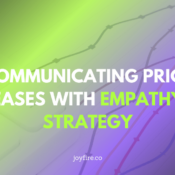
Navigating the 2025 Tariff Impact – Communicating Price Increases with Empathy and Strategy
New tariffs on imports from Canada, Mexico, and China are reshaping our cost structures—and for many businesses, this means it’s time for a price adjustment. While even a modest 1% price increase can push customer churn from 14% to 21%, a thoughtful, empathetic communication strategy can transform this challenge into an opportunity to deepen relationships with your customers.
In today’s world, where everyone is feeling the pinch of increased costs, your message matters more than ever.
Here’s how to approach price increases in a way that’s both strategic and genuinely customer-centric.
1. Understand Your Market Context
Your customers are likely already aware that tariffs are driving up costs across industries. Use this shared reality to your advantage by framing your message within the broader economic landscape.
Acknowledge that the tariffs are a real, external factor—this isn’t an arbitrary decision, but a necessary adjustment to keep delivering the quality they expect.
2. Be Transparent
Customers appreciate honesty—especially when it’s backed up by clear numbers. Don’t be vague (but do share the facts).
Don’t Say – “Due to circumstances beyond our control, we must raise our prices.”
Say This Instead – “New tariffs have increased our raw material costs by 12%. To maintain the quality you rely on, we’re making an 8% price adjustment while absorbing some of the impact ourselves.”
This straightforward approach not only informs your customers but also builds trust by showing that your decision is grounded in reality.
3. Segment Your Communication
Different customers have different needs—and your messaging should reflect that. Segment your communication based on customer type:
- Enterprise Clients – Schedule personal briefings with account managers to discuss the impact and answer questions in detail.
- Mid-Market – Host a virtual webinar (or on-demand webinar) where you break down the numbers and explain the changes.
- Small Business – Send personalized emails outlining how the new pricing will affect them.
- Consumers – Use clear, empathetic digital communications paired with FAQs to guide them through the change.
This targeted approach helps ensure that each group feels heard and understood.
4. Integrate Online and Offline Communication
In today’s digital age, your communication strategy should go beyond emails. Enhance your message with interactive and real-time digital tools – such as ⸺
- Dedicated Landing Page – Create a page that shows new pricing and/or “customer loyalty” bundles.
- Live Chat Support – Offer immediate assistance to customers with questions.
- Social Media Monitoring – Keep an eye on customer sentiment and respond promptly.
- Customer Feedback Integration – Provide channels for customers to share their thoughts and concerns.
These digital touches can demonstrate your commitment to customer service and provide valuable data for refining your approach.
5. Reinforce The Value You Provide
Alongside explaining why prices are rising, remind your customers of the exceptional value they receive. Share performance metrics that underscore your commitment to quality.
For example –
“Even with this 8% increase, we continue to deliver with a 99.7% on-time delivery rate and maintain quality standards that keep our defect rates 50% below the industry average.”
When customers see that your value proposition remains strong, they’re more likely to remain loyal—even in the face of higher prices.
6. Show Empathy (And Mean It)
Smooth the transition with risk mitigation measures that show you care about your customers’ experience.
Here are a few ideas ⸺
- Grandfather Existing Contracts – Offer a 60-day period where current terms are honored.
- Volume-Based Alternatives – Provide options that reward larger purchases.
- Tiered Pricing Structures – Create pricing that reflects different levels of service.
- Loyalty Program Offsets – Introduce incentives that reward long-term commitment.
These initiatives may help soften the impact of the price change and reinforce how much you care about your customer and their satisfaction.
Next Steps
A well-planned rollout can make all the difference. Here’s what that might look like ⸺
- February 4–15 – Roll out strategic communications across channels.
- February 16–28 – Hold individual consultations for high-value and mid-market clients.
- March 1 – New pricing goes into effect.
By planning the timeline, you are more likely to ensure that every customer segment is prepared for the change. Plus, you are more likely to reduce their surprise and reinforce confidence in your brand.
Final Thoughts
Price increases, driven by factors like new tariffs, are an unavoidable reality in today’s market.
How you communicate these changes can set you apart —
- Transparency helps customers understand why prices are changing.
- Advance notice gives them time to adjust.
- Direct, personal communication shows you value them.
- Reinforcing your value reminds them why they do business with you.
- Empathy reassures them you’re on their side.
- Offering alternatives helps soften the impact.
Effective communication can turn potential disruption into an opportunity for leadership and trust.
Need help crafting your tariff response strategy? Book a call with us today. We would be happy to help!




